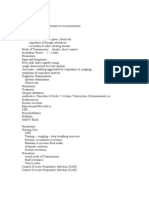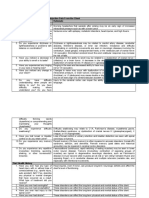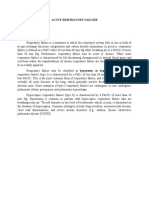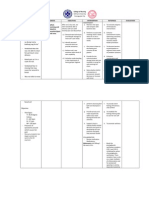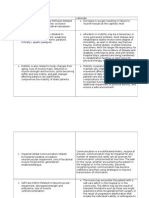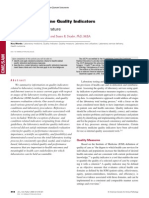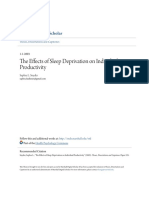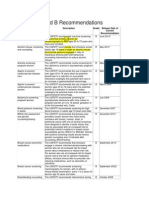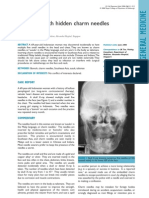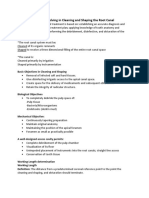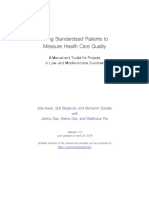Acute Respiratory Failure: Part 1. Failure in Oxygenation
Acute Respiratory Failure: Part 1. Failure in Oxygenation
Uploaded by
nytenurseCopyright:
Available Formats
Acute Respiratory Failure: Part 1. Failure in Oxygenation
Acute Respiratory Failure: Part 1. Failure in Oxygenation
Uploaded by
nytenurseOriginal Title
Copyright
Available Formats
Share this document
Did you find this document useful?
Is this content inappropriate?
Copyright:
Available Formats
Acute Respiratory Failure: Part 1. Failure in Oxygenation
Acute Respiratory Failure: Part 1. Failure in Oxygenation
Uploaded by
nytenurseCopyright:
Available Formats
CRITICAL CARE EXTRA
Acute Respiratory Failure: Part 1. Failure in Oxygenation
When a patient loses the ability to oxygenate the blood. Part one of a two-part article.
By Melinda Smyth, MSN, RN, CCRN, CNA
omething about Amy Morely doesnt seem right. The 53-year-old woman was admitted to the ICU with an exacerbation of chronic obstructive pulmonary disease and has spent two days on mechanical ventilation. Shes been transferred to the medicalsurgical unit, however, because more beds were needed in the ICU, and her vital signs were stable and her pulse oximetry readings were normal. She suffered an acute asthma attack after contracting influenza, and since transfer from the ICU, she has become restless and confused, and her breathing is labored. The ICU nurses and the attending physician are familiar with Ms. Morely, who is taking antidepressants and anxiolytics, and they reassure you that she often acts out and hyperventilates when she doesnt receive enough attention. She has received additional doses of lorazepam (Ativan) and has been placed on assisted ventilation using a bilevel positive airway pressure (BiPAP) device. Ms. Morelys daughter is with her and is very concerned. She tells you that her mother is not making sense. She seems to think shes at home and keeps asking for her poodle, she says.
Melinda Smyth is clinical coordinator of the National Registry of CardioPulmonary Resuscitation for the American Heart Association. Contact author: bludev@bellsouth.net.
ajn@lww.com
Ms. Morely has sinus tachycardia at the rate of 120 beats per minute, her respiratory rate has slowed to 14 breaths per minutes and is irregular, and her pulse oxygen saturation (as measured using pulse oximetry; SpO2) remains high at 98% with the BiPAP machine set at 40%. The respiratory therapist says that hell measure her blood gases in 20 minutes. Ms. Morelys condition deteriorates further, her pulse dropping to a rate of 54 beats per minute and her respiratory rate to 10 breaths per minute. She appears to be deeply asleep; in half an hour, Ms. Morely is in full cardiopulmonary arrest and doesnt respond to any advanced life support intervention. She dies before the attending physician has checked on her. Ms. Morelys story is, unfortunately, true, although her name has been changed. She died of acute respiratory failure, which often goes undetected by physicians and nurses, primarily because the symptoms of it can vary widely, depending on the cause. Medication effects or coexisting structural or metabolic disorders further complicate patient assessment. A life-threatening condition caused by a failure of the respiratory system to efficiently exchange gas, acute respiratory failure results in low oxygen levels, high carbon dioxide levels, and higherthan-normal blood acidity. There
are many possible causes of poor oxygenation, but cases involving poor ventilation (the failure of the muscles of respiration to move air in and out of the pulmonary alveoli) are considered to be in a separate category; even though they ultimately lead to the same failure in oxygenation, the treatment plans differ as the bodys coping mechanisms begin to fail. This article, the first of two concerning acute respiratory failure, deals with a basic failure in oxygenation induced by other causes. A second one, to be published in the June issue, will present an exploration of the failure of ventilation. ACUTE FAILURE OF OXYGENATION The failure of oxygenation can be defined as an arterial partial pressure of oxygen (PaO2) of less than 55 mmHg, when the fraction of inspired oxygen (FiO2) is 0.6 or greater.1 If a patient appears to experience acute oxygenation failure and is at risk for developing hypoventilation, pulmonary edema, acute respiratory distress syndrome, or like Ms. Morely, an acute asthma attack, the nurse or physician should suspect hypoxemia.1-3 Hypoxemia can be the result of hypoventilation, but most cases of severe, acute hypoxemia result from disorders of the alveoli in which the relationship between alveolar ventilation and blood flow or perfusion in the lung is altered.1 Any change in the ratio of ventilation to perfusion is known
AJN May 2005
Vol. 105, No. 5
72GG
CRITICAL CARE EXTRA
as a ventilationperfusion (V/Q) mismatch. It can involve dysfunction in either and can vary in severity, from dead space ventilation, in which the capillary is completely obstructed and cannot receive oxygen (no perfusion takes place), to true shunt, in which no oxygen can pass through the alveolus (there is no ventilation).4 Higher-than-normal V/Q ratios reflect poor blood perfusion, whereas lower-thannormal ratios reflect poor ventilation. A V/Q ratio of 0 is the result of right-to-left shunt units or silent units.5 In conditions of V/Q mismatch and right-toleft shunt, areas of low or absent ventilation relative to perfusion contribute to severe hypoxemia6 because the addition of poorly oxygenated blood from inadequately ventilated areas of the lung to well-oxygenated blood
from normally ventilated areas of the lung produces a venous admixture, blood returning to the left ventricle that is extremely low in oxygen.7 An increase in the patients alveolararterial oxygen (A-a) gradient indicates a V/Q mismatch. SYMPTOMS Oxygenation failure may lead to a rapid deterioration of physiologic functions. Initially, like Ms. Morely was, a patient may be slightly restless and mildly confused, with a rapid heart rate and a respiratory rate thats higher than normal while at rest.8 Clinicians often attribute these seemingly harmless symptoms to less serious conditions, such as anxiety, cognitive impairment, or adverse responses to medication, especially if the increase in the work of breathing obscures the
severity of the underlying hypoxia. Ms. Morelys case underscores the need for nurses always to suspect the worst before assuming that less serious disorders account for a patients symptoms. The physiologic responses in most patients in the early stages of oxygenation failure follow a predictable pattern, regardless of the cause; they are the bodys attempt to stabilize a life-threatening condition and can often lead to a missed diagnosis.9 Acute respiratory failure triggered by an alteration in oxygenation usually creates a compensatory hypocarbia, which is indicated by the presence of respiratory alkalosis (as determined from arterial blood gas [ABG] values). The hypocarbia exists when hypoxemia stimulates the carotid body and aortic body chemoreceptors, leading to an increased sympathetic nervous system discharge, precipitating an increase in the heart rate and an exaggerated ventilatory drive that result in partial pressure of carbon dioxide (PaCO2) values of less than 35 mmHg.1 An enhanced ventilatory drive during the early stages of acute oxygenation failure can disguise a worsening A-a gradient. ASSESSMENT Its important that nurses suspect a failure of oxygenation, even in the absence of specific signs of it or radiographic changes. In the case of Ms. Morely, had the nurses in the ICU understood the complexity of her condition and assessed for oxygenation failure and its causes prior to transferring her, they might have been able to take life-saving measures. Often, there are no adventitious breath sounds and chest X-rays are clear during the early stages of the disease; such changes become apparent only later. The
nurse must determine and report the patients vital signs, neurologic status, cardiac rhythm, fluid balance during the previous 24 to 48 hours, preceding laboratory results, ABG values, the SpO2 level, complete blood count, and any deviation from normal assessment findings. In Ms. Morelys case, peak expiratory flow rate testing, which is noninvasive and inexpensive, could easily have been performed by the respiratory therapist. Peak expiratory flow rates between 50% and 70% of the patients personal best indicate severe airway obstruction. A peak flow rate of less than 50% is cause for grave concern. Ms. Morelys nurses should have insisted also upon ABG analysis immediately because the PaCO2 level would have been helpful in staging the asthma attack. The development of hypercapnia in a patient with severe asthma indicates the final stages of an attack and the risk of cardiopulmonary arrest.3 Nurses should also be aware that patients at high risk for a V/Q mismatch and a resultant failure of oxygenation are those who have experienced some form of shock (cardiogenic, hypovolemic, or septic), including, but not limited to, cardiac failure, long-bone fractures, smoke inhalation, deep vein thrombosis or pulmonary embolism (or both), bronchospastic disease, pulmonary contusion, pneumonia, or traumatic injury.10 Interventions and diagnostic testing are determined according to the suspected etiology of the V/Q mismatch. Cellular hypoxia doesnt follow the same pattern in all patients, however, and even in the presence of a relaxed appearance or normal vital signs, close attention should be paid to the patients level of consciousness, complaints, laboratory test results (including
CRITICAL CARE EXTRA
the SpO2 level and ABG values), urinary output, cardiac rhythm, and the color and temperature of the skin. Patients with suppressed sympathetic nervous systems, including those receiving adrenergicblocking agents or medication for pain or sedation, as well as those who have spinal cord injuries or who are in a weakened, malnourished state, can be severely hypoxic yet still have normal heart and respiratory rates.11 Those patients may exhibit subtle signs of confusion or anxiety, but drugs, disease, and injury can depress the normal sympathetic responses. Such patients can progress quickly to a decompensated state with only subtle changes in other physiologic parameters. There are many technologies available to determine the severity of a patients respiratory insufficiency. Testing for mixed
venous oxygen saturation (SvO2) provides the most comprehensive and reliable results but is not widely used because its expensive and makes the patient uncomfortable. Pulse oximetry is the test most widely used for respiratory assessment, but it doesnt always present a true picture of oxygenation, especially in cases of acute asthma with hyperventilation or in which supplemental oxygen is in use.3 If a patient is severely anemic, pulse oximetry might indicate high saturation, despite a significant cellular oxygen debt because of the hemoglobins limited oxygen-carrying capacity.3 In addition, pulse oximetry doesnt quantify variations in hemoglobins affinity for oxygen, which changes in response to certain conditions, altering the normal relationship between PaO2 and arterial oxy-
gen saturation. An increase in hemoglobins affinity for oxygen occurs in conditions in which there is a low metabolic rate, resulting in higher hemoglobin saturation for a given PaO2. These conditions, which include alkalosis, decreased PaCO2 values, hypothermia, and depleted stores of 2,3-diphosphoglycerate (2,3-DPG), an intermediate metabolite of glucose that facilitates dissociation of oxygen from hemoglobin at the tissue level,8, 12 cause a variation in the normal oxyhemoglobin dissociation curve known as a shift to the left.8 Although SpO2 values may appear satisfactory, greater hemoglobin binding impairs oxygen unloading at the cellular level and reduces the amount of oxygen dissolved in plasma. When those conditions occur, the gas diffusion gradient or driving pressure of
CRITICAL CARE EXTRA
dissolved oxygen may be inadequate for intracellular transport. Conversely, a decrease in hemoglobins affinity for oxygen occurs in conditions in which there is a high metabolic rate, such as acidosis, hyperthermia, hypercapnia, and elevated levels of 2,3DPG,8, 12 conditions that result in a shift of the oxyhemoglobin dissociation curve to the right. Although the pulse oximeter may reflect a slightly lower-than-normal PaO2 value, oxygen is more readily available for intracellular transport because of decreased hemoglobin binding. However, that state of decreased hemoglobin affinity for oxygen may slow the loading of oxygen at the alveolarcapillary membrane level. Dysfunctional hemoglobin, such as carboxyhemoglobin in heavy smokers or methemoglobin in patients exposed to excessively
high levels of nitrate medications,13 cannot bind or carry oxygen effectively, and high levels yield faulty SpO2 results. In such cases, only laboratory testing can determine the actual percentage of dysfunctional hemoglobin. Specific interventions for elevated dysfunctional hemoglobin levels include increasing the FiO2 by turning up the percentage of delivered oxygen, hyperbaric oxygenation, and in the case of a severely elevated carboxyhemoglobin level, decreasing the demand for oxygen by restricting patient activities and controlling fever, anxiety, pain, or shivering. In the case of an elevated methemoglobin level, the intake of nitrates should be decreased.13 As long as one keeps in mind the limitations of pulse oximetry, that technology can remain an inexpensive, uninvasive
means of following trends and warning of significant changes in hemoglobin saturation (although its not an indication of overall oxygen supply).3 GOALS OF CARE Patients with acute oxygenation failure deteriorate rapidly when compensatory mechanisms break down. Unless disease-specific intervention occurs promptly, the increase in the work of breathing quickly leads to respiratory muscle fatigue, worsening hypoxia and gradually increasing PaCO2 levels.14 If left untreated, the patient will progress to a state of exhaustion, resulting in a failure of ventilation, worsening hypoxia, anaerobic metabolism, and resultant end-organ tissue destruction. If the patient exhibits signs of oxygenation failure, nurses should optimize oxygen
CRITICAL CARE EXTRA
delivery, minimize oxygen consumption, and determine the underlying cause of V/Q mismatch so that specific treatment can be initiated.8, 9 Nurses should continually assess breath and heart sounds. Breath sounds and wheezes become diminished, and heart sounds become muffled as the patient approaches the end stages of an asthma attack. Its also imperative that nurses pay attention to changes in the patients mental status and to decreases in the respiratory rate; mental lethargy and decreases in the level of consciousness can result as carbon dioxide levels begin to increase. When the oxygen supply is inadequate to meet metabolic requirements, the demand for oxygen should be minimized. Coexisting clinical conditions or concurrent treatments that increase oxygen uptake, such as fever, shivering, seizures, burns, hyperthyroidism, agitation, anxiety, pain, a high metabolic rate, increased patient care activities, or high-carbohydrate feeding, necessitate vigilance.9 Also, any nonessential patient care activities should be delayed to reduce global demand. If a patient experiencing a failure of oxygenation displays extreme agitation, anxiety, and air hunger, sedation is contraindicatedeven though those psychomotor responses increase oxygen demandunless the airway is managed and ventilation is mechanically controlled. Ms. Morely should not have received either lorazepam because its a benzodiazepine and a strong respiratory depressant. Even though she was agitated, the agitation stemmed from oxygenation failure and bronchospasm. After receiving the benzodiazepine, she experienced a diminished respiratory drive and became more hypoxic and obtunded. As the PaCO2 level
ajn@lww.com
rose, she quickly progressed to status asthmaticus, the end stage of asthma attack; her body was no longer responding to the agonists, and the result was cardiopulmonary arrest. When applied early in oxygenation failure, interventions to reduce the work of breathing and improve V/Q matching are helpful in improving patient outcomes.14, 15 Such strategies improve oxygen supply and may reduce oxygen demand. The use of supplemental oxygen (and the patients increased respiratory drive) allows some patients to maintain PaO2 levels close to normal during the early stages of hypoxemic failure.3 In some cases, such as in the early stages of adult respiratory distress syndrome, early airway management and mechanical ventilation can improve outcomes. In other cases, such as in patients with pulmonary emboli or asthma, the crisis can best be managed by pharmacologic or noninvasive ventilatory support (or both), coupled with frequent patient monitoring.1 A BiPAP machine, which provides partial respiratory support, can decrease the work of breathing, but it should be used with caution in cases of poor airway management or lethargy because there will be no control of the airway or ventilation if the patient fails to initiate a breath. Nurses, who often are the primary bedside caregivers to acutely ill, hypoxic patients, have an opportunity to improve their patients overall outcomes by being attentive to subtle changes in condition and maintaining a high level of clinical expertise in managing acute respiratory failure. The second part of this article will present an exploration of the failure of ventilation, in which presentation, etiology, and interventions are somewhat different
from those seen in the failure of oxygenation.
REFERENCES
1. Grippi M. Respiratory failure: an overview. In: Fishman AP, et al., editors. Fishmans pulmonary diseases and disorders. New York: McGrawHill; 1998. p. 2525-35. 2. Baker C, et al. Triangle of death: hypothermia, acidosis, and coagulopathy. New Horiz 1999;7:61-72. 3. Alex C, Tobin M. Assessment of pulmonary function in critically ill patients. In: Grenvick A, al e, editors. Textbook of Critical Care. Philadelphia; 2000. p. 1222-31. 4. Scanlon C. Gas exchange and transport. In: Scanlon C, et al., editors. Fundamentals of respiratory care. St. Louis: Mosby; 1999. p. 215-40. 5. St. John R. The pulmonary system. In: Alspach J, editor. Core curriculum for critical care. Philadelphia: Saunders; 1998. p. 1-136. 6. Brimioulle S, et al. Importance of hypoxic vasoconstriction in maintaining oxygenation during acute lung injury. Crit Care Med 2002; 30(4):874-80. 7. Guyton A. Textbook of medical physiology. Philadelphia: W. B. Saunders; 1991. 8. Ahrens T, Powers C. Pulmonary clinical physiology. In: Kinney M, et al., editors. AACN clinical reference for critical care nursing. St. Louis: Mosby; 1998. p. 491-516. 9. Vary T, Littleton-Kearney M. Pathophysiology of traumatic shock and multiple organ system failure. Cardona V, et al., editors. Philadelphia: W. B. Saunders; 1994. p. 114-50. 10. Vollman K, Aulbach R. Acute respiratory distress syndrome. In: Kinney M, et al., editors. AACN clinical reference for critical care nursing. St. Louis: Mosby; 1998. p. 529-64. 11. Kotterba S, et al. Respiratory monitoring in neuromuscular disease capnography as an additional tool? Clin Neurol Neurosurg 2001;103(2): 87-91. 12. Christie H, Goldstein L. Respiratory failure and the need for ventilatory support. In: Scanlon C, et al., editors. Egans fundamentals of respiratory care. St. Louis: Mosby; 1999. p. 819-32. 13. Boylston M, Beer D. Methemoglobinemia: a case study. Crit Care Nurse 2002;22(4):50-5. 14. Hynes-Gay P, MacDonald R. Using high-frequency oscillatory ventilation to treat adults with acute respiratory distress syndrome. Crit Care Nurse 2001;21(5):38-47. 15. Yu M. Oxygen transport optimization. New Horiz 1999;7:46-53.
AJN May 2005
Vol. 105, No. 5
72OO
You might also like
- Keith RN Asthma Case StudyDocument16 pagesKeith RN Asthma Case StudyCHARLES MAINANo ratings yet
- Pendulum The Ultimate Guide To The Magic of Pendulums and How To Use Them For Divination, Dowsing, Tarot Reading, Healing, And... (Mari Silva) (Z-Library)Document137 pagesPendulum The Ultimate Guide To The Magic of Pendulums and How To Use Them For Divination, Dowsing, Tarot Reading, Healing, And... (Mari Silva) (Z-Library)Melsry100% (6)
- Zheng-Cai Liu - A Study of Daoist Acupuncture PDFDocument241 pagesZheng-Cai Liu - A Study of Daoist Acupuncture PDFRā Åmma Åresh Bakau100% (16)
- VSim SARAH LIN For Nursing - Health Assessment POST QUIZDocument5 pagesVSim SARAH LIN For Nursing - Health Assessment POST QUIZWen RodsaNo ratings yet
- Lewis COPD Case StudyDocument2 pagesLewis COPD Case Studyatarisgurl08No ratings yet
- Transitional Care Case Study-Pulling It All TogetherDocument13 pagesTransitional Care Case Study-Pulling It All TogethermatthewNo ratings yet
- Discussion QuestionsDocument2 pagesDiscussion QuestionsMary RiasNo ratings yet
- Abdominal Blunt TraumaDocument6 pagesAbdominal Blunt TraumaYunes AryoNo ratings yet
- Case Study: Acute Exacarbation Chronic Obstructive Aspiration Disease (Aecoad)Document5 pagesCase Study: Acute Exacarbation Chronic Obstructive Aspiration Disease (Aecoad)Muhammad Alif100% (1)
- Chronic Kidney Disease: Prepared by Zakia RogerDocument27 pagesChronic Kidney Disease: Prepared by Zakia Rogerbene dugaNo ratings yet
- EclampsiaDocument56 pagesEclampsiagalihtrimuninggarNo ratings yet
- Pleural Effusion Case StudyDocument31 pagesPleural Effusion Case StudyHomework PingNo ratings yet
- Pediatric NursingDocument14 pagesPediatric NursingJoanne PaulineNo ratings yet
- COPD: Pathogenesis Environmental Insult To Lungs Genetic SusceptibilityDocument1 pageCOPD: Pathogenesis Environmental Insult To Lungs Genetic SusceptibilityMaria Vhanesa AbuyanNo ratings yet
- Fluid Volume Deficit Nursing Care PlanDocument4 pagesFluid Volume Deficit Nursing Care PlanTipey SegismundoNo ratings yet
- Cerebrovascular Disease (Bleed)Document25 pagesCerebrovascular Disease (Bleed)Margaret Jenaw JenawNo ratings yet
- End Stage Renal DiseaseDocument2 pagesEnd Stage Renal DiseaseAynie SuriagaNo ratings yet
- Pneumonia Causative Agent: 1. Infectious - Bacteria (Streptococcus Pneumonia) Virus FungiDocument2 pagesPneumonia Causative Agent: 1. Infectious - Bacteria (Streptococcus Pneumonia) Virus FungiFreeNursingNotes100% (1)
- Actual SoapiesDocument8 pagesActual SoapiesBeverlyn AsparoNo ratings yet
- CA PEDIA Hand OutDocument13 pagesCA PEDIA Hand OutarianeNo ratings yet
- Nursing Care Plan Sample For BeginnersDocument15 pagesNursing Care Plan Sample For BeginnersMoe KhanNo ratings yet
- Nursing DiagnosisDocument9 pagesNursing Diagnosiskhikmatul mu'jizahNo ratings yet
- Ineffective Tissue Perfusion Nursing Care PlanDocument1 pageIneffective Tissue Perfusion Nursing Care PlankimmybapkiddingNo ratings yet
- Electrolyte ImbalanceDocument4 pagesElectrolyte ImbalanceDoneva Lyn MedinaNo ratings yet
- IV Therapy - Asynchronous ActivityDocument2 pagesIV Therapy - Asynchronous ActivityNicole Chloe OcanaNo ratings yet
- Nursing Interview Guide To Collect Subjective Data From The Client Questions RationaleDocument19 pagesNursing Interview Guide To Collect Subjective Data From The Client Questions RationaleKent Rebong100% (1)
- GROUP 3 - CASE STUDY - TraumaDocument5 pagesGROUP 3 - CASE STUDY - TraumaDinarkram Rabreca EculNo ratings yet
- Set 1Document62 pagesSet 1Alyssa MontimorNo ratings yet
- Noninvasive VentilationDocument6 pagesNoninvasive VentilationEma MagfirahNo ratings yet
- Case Study For Acute Respiratory FailureDocument10 pagesCase Study For Acute Respiratory FailureGabbii CincoNo ratings yet
- Clinical Log-5 Tibia #Document5 pagesClinical Log-5 Tibia #Tahani KhalilNo ratings yet
- The Main Applications of The ECG Nursing Lecture NotesDocument19 pagesThe Main Applications of The ECG Nursing Lecture NotesMaria Rowena O. SalvoNo ratings yet
- Self Care DeficitDocument3 pagesSelf Care DeficitKharma LigoresNo ratings yet
- Part 2 Gastro New NotesDocument12 pagesPart 2 Gastro New NotesanreilegardeNo ratings yet
- A Case PresentationDocument50 pagesA Case PresentationAnaleah MalayaoNo ratings yet
- Cardio QuizDocument100 pagesCardio QuizEvidence ChaibvaNo ratings yet
- TetanusDocument23 pagesTetanusNadya Noor Mulya Putri100% (1)
- Guillain Barre Case StudyDocument18 pagesGuillain Barre Case Studymydnyt02No ratings yet
- Arterial Blood Gas (ABGs) Analysis Ultimate Guide - NurseslabsDocument1 pageArterial Blood Gas (ABGs) Analysis Ultimate Guide - NurseslabsJanmarie BongcaronNo ratings yet
- Pulmonary PathoPhysiologyDocument45 pagesPulmonary PathoPhysiologySuliman Garalleh100% (1)
- Nanda Needs ListDocument24 pagesNanda Needs ListObrian ReidNo ratings yet
- Case Report: Suspect of Rupture Abdominal Aortic Aneurysm Aorta DissectionDocument52 pagesCase Report: Suspect of Rupture Abdominal Aortic Aneurysm Aorta DissectionAnatasia A. YNo ratings yet
- NCPDocument10 pagesNCPCristina L. JaysonNo ratings yet
- Nursing Care Plan: Name: DRT Age: 67 Diagnosis: Cva 2° To HPNDocument3 pagesNursing Care Plan: Name: DRT Age: 67 Diagnosis: Cva 2° To HPNKristina Marie Parulan RnNo ratings yet
- NCP Acute Pain NCSDocument3 pagesNCP Acute Pain NCSPaolo Vittorio Perdigueros GonzalesNo ratings yet
- GERD Gastroesophageal Reflux Disease NCLEX ReviewDocument12 pagesGERD Gastroesophageal Reflux Disease NCLEX ReviewBianca Trish ManlangitNo ratings yet
- Dr. H. Achmad Fuadi, SPB-KBD, MkesDocument47 pagesDr. H. Achmad Fuadi, SPB-KBD, MkesytreiiaaNo ratings yet
- Uremic EncephalophatyDocument48 pagesUremic EncephalophatySindi LadayaNo ratings yet
- Ineffective Cerebral Tissue Perfusion Related ToDocument7 pagesIneffective Cerebral Tissue Perfusion Related TohannahNo ratings yet
- Nursing Care Plan For SCIDocument10 pagesNursing Care Plan For SCINur SanaaniNo ratings yet
- Atropine SulfateDocument4 pagesAtropine SulfateSuraya_Mohamed_3281No ratings yet
- NCP Angina Coronary Artery DiseaseDocument6 pagesNCP Angina Coronary Artery DiseaseRon Batacan De LeonNo ratings yet
- DrugsDocument13 pagesDrugsJune DumdumayaNo ratings yet
- DR ReDocument16 pagesDR RehakdogNo ratings yet
- Week 16 Gi and Gyne CancerDocument15 pagesWeek 16 Gi and Gyne Cancerjmmacar19No ratings yet
- Opd Soap Format: For Follow Up PatientsDocument2 pagesOpd Soap Format: For Follow Up PatientsMicaNo ratings yet
- Acute Biologic Crisis: Nina Hamili G. Piao RNDocument62 pagesAcute Biologic Crisis: Nina Hamili G. Piao RNNina OaipNo ratings yet
- Ventricular Septal Defect, A Simple Guide To The Condition, Treatment And Related ConditionsFrom EverandVentricular Septal Defect, A Simple Guide To The Condition, Treatment And Related ConditionsNo ratings yet
- COMPREHENSIVE NURSING ACHIEVEMENT TEST (RN): Passbooks Study GuideFrom EverandCOMPREHENSIVE NURSING ACHIEVEMENT TEST (RN): Passbooks Study GuideNo ratings yet
- The Ride of Your Life: What I Learned about God, Love, and Adventure by Teaching My Son to Ride a BikeFrom EverandThe Ride of Your Life: What I Learned about God, Love, and Adventure by Teaching My Son to Ride a BikeRating: 4.5 out of 5 stars4.5/5 (2)
- NURSING CARE OF ADULTS II: Passbooks Study GuideFrom EverandNURSING CARE OF ADULTS II: Passbooks Study GuideNo ratings yet
- Paranasal Sinus Cancer A Simple Guide To The Condition, Diagnosis, Treatment And Related ConditionsFrom EverandParanasal Sinus Cancer A Simple Guide To The Condition, Diagnosis, Treatment And Related ConditionsNo ratings yet
- Laboratory Medicine Quality IndicatorsDocument14 pagesLaboratory Medicine Quality IndicatorskinnusaraiNo ratings yet
- Drug Study - Ketorolac, Tromethamine, OmeprazoleDocument4 pagesDrug Study - Ketorolac, Tromethamine, OmeprazolemikErlhNo ratings yet
- Oxford Research Encyclopedia of Psychology: Evaluation of Psychological Interventions in Sport and Exercise SettingsDocument35 pagesOxford Research Encyclopedia of Psychology: Evaluation of Psychological Interventions in Sport and Exercise SettingsPSICOLOGIA DEPORTIVANo ratings yet
- C - Syiam Amalia Rahmah - Topik 4Document7 pagesC - Syiam Amalia Rahmah - Topik 4Syiam Amalia RahmahNo ratings yet
- 紅寶ListDocument66 pages紅寶ListEden ChengNo ratings yet
- Pyrogen Test and Its Determination Using Rabbits - Pharmaceutical GuidelinesDocument1 pagePyrogen Test and Its Determination Using Rabbits - Pharmaceutical Guidelinesstalker akoNo ratings yet
- Lewy Body Dementia SlidesDocument111 pagesLewy Body Dementia SlidesDilini de Silva-ChenNo ratings yet
- The Effects of Sleep Deprivation On Individual ProductivityDocument31 pagesThe Effects of Sleep Deprivation On Individual ProductivityJESSIANo ratings yet
- Nanoparticles in Drug Delivery SystemsDocument43 pagesNanoparticles in Drug Delivery SystemsRajul RkgNo ratings yet
- USPSTF A and B RecommendationsDocument5 pagesUSPSTF A and B RecommendationsArsalan Talib HashmiNo ratings yet
- Gestalt Therapy and HypnosisDocument7 pagesGestalt Therapy and Hypnosischoileo100% (1)
- Company Wise Top BrandsDocument20 pagesCompany Wise Top Brandsshahadat.maymunaNo ratings yet
- Body MRI Artifacts in Clinical Practice: A Physicist's and Radiologist's PerspectiveDocument19 pagesBody MRI Artifacts in Clinical Practice: A Physicist's and Radiologist's PerspectiveaegysabetterwayNo ratings yet
- Susuk X RayDocument2 pagesSusuk X RayMasjid Bandar Bukit PuchongNo ratings yet
- Problem Solving in Cleaning and Shaping The Root CanalDocument10 pagesProblem Solving in Cleaning and Shaping The Root CanalEdgar CortezNo ratings yet
- Elisabeth Johanne Rook: Curriculum VitaeDocument2 pagesElisabeth Johanne Rook: Curriculum VitaeAbdullah TheNo ratings yet
- RST 410 Incident ReportDocument2 pagesRST 410 Incident Reportapi-377278607No ratings yet
- Grain LessDocument6 pagesGrain Lesschris'sNo ratings yet
- Existential Child TherapyDocument256 pagesExistential Child TherapySasu NicoletaNo ratings yet
- Dr. ArunkumarDocument6 pagesDr. ArunkumarArunkumarmenganeNo ratings yet
- Stopping or Reducing Dietary Fiber Intake Reduces ConstipationDocument4 pagesStopping or Reducing Dietary Fiber Intake Reduces ConstipationleonardopinheiroNo ratings yet
- Premedication: Moderator: DR - Dinesh Kaushal Presentsd By: DR Rajesh Raman & DR Gopal SinghDocument60 pagesPremedication: Moderator: DR - Dinesh Kaushal Presentsd By: DR Rajesh Raman & DR Gopal Singhramanrajesh83No ratings yet
- Using Standardized Patients To Measure Health Care QualityDocument250 pagesUsing Standardized Patients To Measure Health Care QualityBenjamin DanielsNo ratings yet
- Cook, J. D. (2003Document11 pagesCook, J. D. (2003Márcia LoureiroNo ratings yet
- Responsible Use of Medicines Handbook - IPA PDFDocument110 pagesResponsible Use of Medicines Handbook - IPA PDFRamaNo ratings yet
- 1 - Cloning Vectors PDFDocument44 pages1 - Cloning Vectors PDFUsman ShamshadaliNo ratings yet
- Uniparental DisomyDocument17 pagesUniparental DisomyBabak NamiNo ratings yet
- Comparative Study of UK, USA and Indian Health Care SystemDocument12 pagesComparative Study of UK, USA and Indian Health Care SystemArnab Chatterjee67% (3)

















